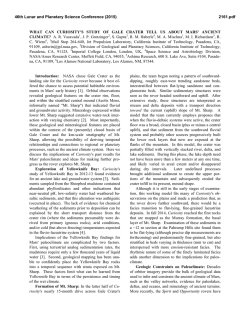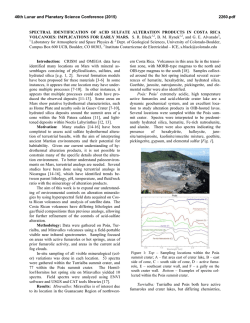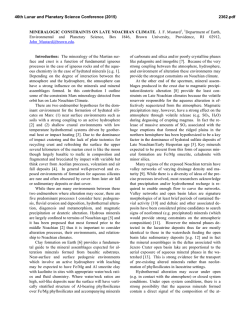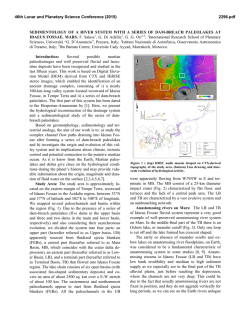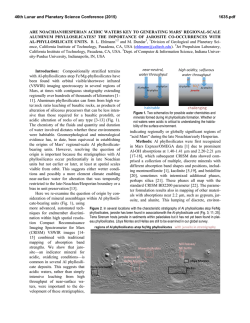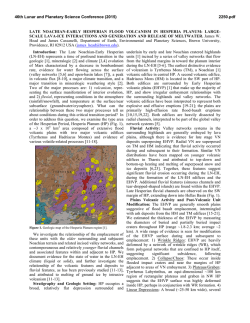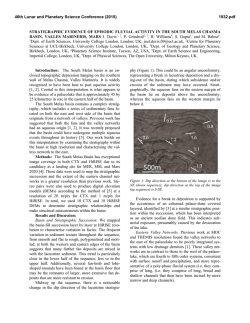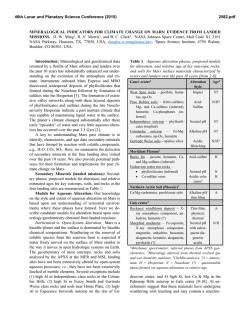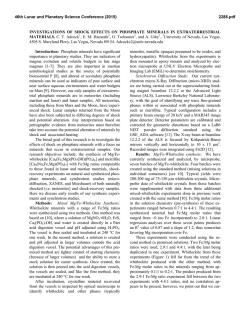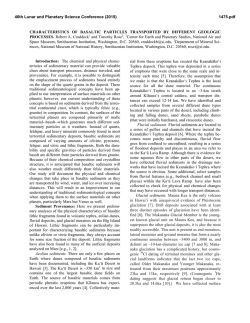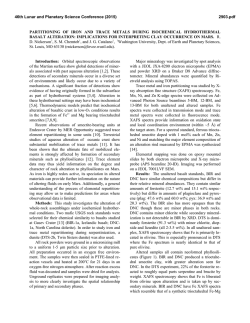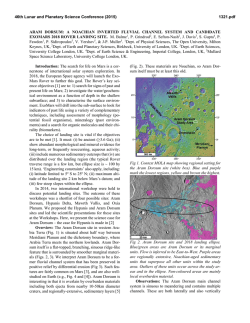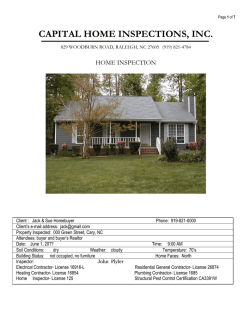
FLUVIAL STRUCTURES, DELTAS AND MINERAL SPECTRAS
46th Lunar and Planetary Science Conference (2015) 1824.pdf FLUVIAL STRUCTURES, DELTAS AND MINERAL SPECTRAS – EVALUATORS OF WEATHERING CONDITIONS ON MARS. A. Kereszturi1 1Research Center for Astronomy and Earth Sciences, H 9400 Sopron, Csatkai u. 6-8, Hungary. (E-mail: [email protected] ). Introduction: There is an onlgoing debate on how much weathering products (and related warm-wet climate) are in the ancient fluvial structures on Mars, were transported there or formed in-situ. While certain ratio of alterational minerals that are present in the sedimentary fans must be re-deposited and accumulated there, minerals also possibly formed there. Although during the identification spectral masking (by goethite and ferryhydrite) might hide the VNIR signatures of other alterational products [1] several arguments point to small amount of alteration happened in he fans, while strong and widespread early weathering [2] might happened on Mars. Minerals in lacustrine basins: Phyllosilicates often occur in the bottom of fans and they resemble spectrally to outcrops in the drainage area, supporting they are redeposted and not formed there [3]. Sources for weathered minerals in such cases thus are not from fluvial but from other, like hydrothermal or pedigenic processes. Here only the source region of the flows and does matter there, like for example in the case of plateau phyllosilicates at Valles Marineris [4]. Little evidence for joint alteration in fluvial systems with clays are present, and many clays without fluvial marking on Noacian terrains are frequent. The general view is most phyllosilicates could be formed by some Noachian aged shallow subsurface water. Best candidates: Opposite to the above mentioned arguments, chlorides are more easily produced by desiccation just like some hydrated sulfates. Partly opaline (the main hydrated phase in many fans [5]) could be also considered as in-situ produced but less probable than evaporites. While the evaporation naturaly produce chloride salts from brines, for opaline forma- tion aric and acid conditions are required on the Earth with low water/rock ratio. Future directions: Chloride bearing fans might provide the missing link toward the analysis of alteration in fluvial and related lacustrine systems, as their formation is connected somewhat to the duration of aqueous phase there. While the flow could transport other minerals from the source region, evaporites probably accumulate in the topset region of fans, and could be resemble to the evaporates in the deepest part of the basin. The clay/chloride ratio thus could be used as a possible evaluator for transported vs. in-situ alteration. Figure 1. Examples on the differences between transported and in-situ altered minerals containing systems (hypothetical positions with numbers from Table 1.) Analyzing this ratio ideal fans could be selected for detailed research on alteration in the fluvial/lacustrine environment. Some example structures are indicated in Table 1. and their context (rough position) in this visualized in Figure 1. Acknowledgment: The support of the OTKA PD 105970 is acknowledged. References: [1] Cull et al. (2014) EPSL 403, 217224 [2] Carter et al. (2015) Icarus 248, 373-382. [3] Murchie et al. (2009) JGR 114, 1-30. [4] Le Deit (2012) JGR 117(E3), E00J05. [5] Carter et al. (2012) LPSC #1978. Table 1. Some possible “arche types” of wet alteration products on Mars at fluvial systems n name, location 1 Jezero crater (18.5N, 77.4E) 2 unamed crater (2.7N 308.3E) 3 Terby crater (28S, 73E) general description transported and re-deposited weathered minerals below the frontal edge of the fan, possible authigenic thick layered sediments identified minerals (data source) Mg-carbonate, Fe/Mg smectite (CRISM HRL000040FF) opaline and/or Al-smectite (HRL 975E) Fe/Mg-smectites, zeolites or sulfates 4 70 km unnamed crater (30S 202E) 5 Shalbatana delta (3N 316E) 6 unnamed valley, Sirenum basin (33S 216E) possible acid-saline, evaporative lacustrine deposit hydrated minerals in lacustrine beds chloride filled valley alunite, montmosillonite, kaolinite, halloysite, Fe/Mg/Al-phyllosilicates, polyhydrated sulfates, opal valley cut through clay-bearing deposits (PSP_007050_1465, FRT 9AAA) publication Ehlmann et al. (2009) JGR 114, E00D08 Carter et al. (2012) LPSC #1978 Ansan et al. (2011) Icarus 211, 273–304. Swayze et al. (2008) AGU Fall 11/2008; 1:04. Di Achille, G. et al. (2009) GRL, 36, L14201 Wray et al. (2009) Geology 37, 1043-1046.
© Copyright 2026
